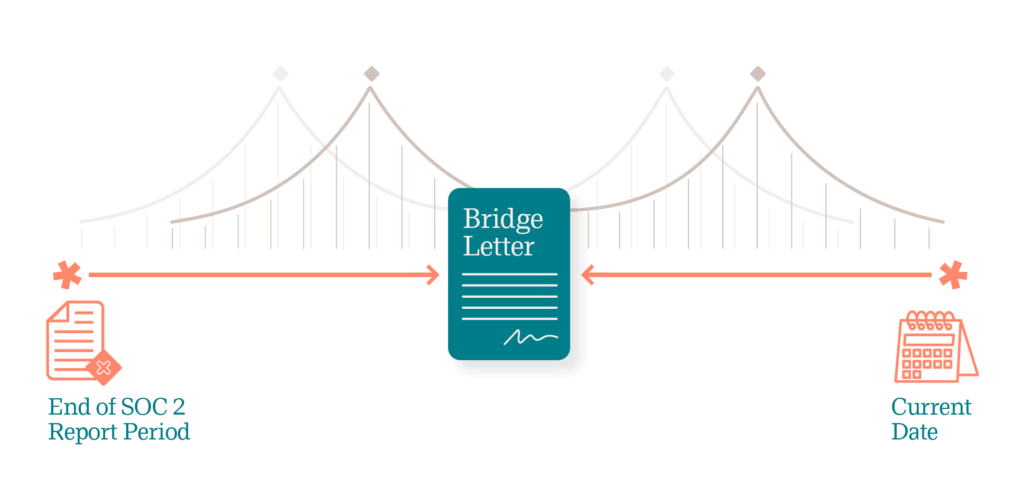When it comes to maintaining the integrity and trustworthiness of your organization’s information security practices, SOC 2 attestation is a critical component to help provide assurance to customers, their auditors, and potential business partners.
However, there are instances where the reporting period of a SOC 2 audit does not align perfectly with a company’s fiscal year or dating requirements of other stakeholders. This is where bridge letters come into play.
What Is SOC 2?
Before diving into bridge letters, let’s recap what SOC 2 is. SOC 2 (System and Organization Controls 2) is a type of audit report that evaluates an organization’s controls relevant to the AICPA’s Trust Services Criteria: security, availability, processing integrity, confidentiality, and privacy.
Obtaining SOC 2 attestation is crucial for service organizations that handle sensitive customer data because doing so assures clients and stakeholders that the service organization maintains robust data security measures. Many customers, especially large enterprises, consider a clean SOC 2 report as a basic requirement as they evaluate potential service providers.
To gain a deeper understanding of SOC 2 reports and their components, please refer to our article, “Key Elements of a SOC 2 Report”.
What Is a Bridge Letter?
A bridge letter, also known as a gap letter, is a document provided by a service organization (not the service auditor) to address the gap between the SOC 2 audit reporting period and the current date. The bridge letter provides interim (and unverified) assurance that the controls evaluated in the last SOC 2 audit report are still in place and operating effectively.

Why Are Bridge Letters Important?
Bridge letters provide several benefits, including continuity of assurance. Clients and stakeholders rely on SOC 2 reports to assess the security posture of a service organization. A bridge letter ensures there is no gap in assurance between the end of the audit period and the next scheduled audit.
Bridge letters also help service organizations meet their Contractual obligations. Many contracts and regulatory requirements stipulate continuous compliance with internal controls. Bridge letters help organizations provide assurance they are meeting these obligations during the interim period.
They also support business continuity during situations such as mergers, acquisitions, or new business deals, where having an up-to-date assurance of SOC 2 compliance is crucial. A bridge letter provides the necessary assurance for participants to proceed with confidence.
Key Elements of a Bridge Letter
A well-crafted bridge letter typically includes the following elements:
- Statement of Continuity: A declaration that the controls outlined in the most recent SOC 2 report remain in place and are operating effectively.
- Period Covered: A clear indication of the dates covered by the bridge letter. This is typically from the end of the last audit period to the current date, or the date of the next audit.
- Changes and Updates: Disclosures of any significant changes in the organization’s control environment since the last SOC 2 report.
- Signatory: The bridge letter should be signed by an authorized representative of the service organization, typically the chief information security officer (CISO), compliance officer or a similar authority.
Best Practices for Issuing Bridge Letters
Service organizations issuing bridge letters should keep the following in mind:
- Timeliness: Ensure the bridge letter is issued promptly to avoid gaps in assurance.
- Transparency: Outline clearly any changes or incidents that may have affected the service organization’s internal control environment since the last audit.
- Regular Updates: Revise bridge letters as needed, especially if there are significant changes in the control environment.
- Consultation with Auditors: Engage with your auditors to ensure the bridge letter reflects the current state of controls accurately and addresses any concerns they may have.
Bridge letters play a crucial role in maintaining continuous assurance of a service organization’s SOC 2 control environment. They provide customers, stakeholders, and regulatory bodies with assurance the organization’s controls remain robust and effective between audit periods.
By understanding and using bridge letters effectively, service organizations can provide ongoing trust and compliance in their data security practices.
To learn more about SOC 2 audits and the role of bridge letters, get in touch with our team.
















